In an era where innovation is not just valued but essential for survival and growth, the concept of blue sky thinking has become increasingly relevant.
It’s a term that evokes the image of limitless horizons and boundless possibilities.
But what does it really mean to engage in blue sky thinking, and how can it transform the way we approach challenges and opportunities?
Today, I will discuss the essence of blue sky thinking, revealing its components, significance, and practical applications in our daily lives and work environments.
Key Takeaways
The Essence of Blue Sky Thinking

At its core, blue sky thinking is about brainstorming without bounds. It’s a process that encourages participants to consider options without constraints, fostering innovative ideas by pushing beyond comfort zones.
This approach is built on the premise that to arrive at truly groundbreaking solutions, one must be willing to challenge conventional approaches and dare to ask, “What if…?”.
Why Is It Called “Blue Sky Thinking”?
The term “blue sky” suggests limitless potential and infinite possibilities, much like the sky above us.
In blue sky thinking, there are no limits to the creativity and innovation that can be explored.
This mindset is crucial for generating ideas that are not only creative but sometimes unexpectedly realistic and practical, even when faced with projects that have limited budgets and deadlines.
The Power of Unconstrained Brainstorming

Blue sky thinking is synonymous with innovative thinking, creative ideas, and out-of-the-box thinking. It’s about liberating the mind to explore ideas that at first may seem too bold or unconventional. This section explores how blue sky thinking, through its emphasis on unconstrained brainstorming, can lead to innovative solutions.
How Does Blue Sky Thinking Foster Innovation?
- Encouraging Collaboration: Collaboration is essential in blue sky thinking. It’s through the exchange of ideas in sessions like meetings, workshops, and forums that concepts can be refined and enhanced.
- Challenging the Status Quo: By challenging conventional approaches and thinking, blue sky thinking paves the way for creative and impactful results. It transforms “stuck” projects and ideas into opportunities for innovation.
- Exploring Unconventional Solutions: Daring to explore unconventional solutions allows for the generation of ideas that are not only imaginative but also feasible and applicable in real-world scenarios.
Practical Applications of Blue Sky Thinking
While the concept might seem geared towards lofty, theoretical discussions, blue sky thinking has numerous practical applications.
It’s about finding feasible, viable, and realistic solutions to problems, even under constraints.
This section covers how blue sky thinking can be applied to various aspects of work and life.
Can Blue Sky Thinking Be Realistic?
Absolutely. While blue sky thinking encourages going beyond the obvious, it also involves grounding ideas in reality.
The process helps sift through imaginative concepts to find practical, achievable, and workable solutions.
This balance between creativity and practicality is what makes blue sky thinking a powerful tool.
Strategies for Effectiveness
Implementing blue sky thinking requires a deliberate approach. Here are some strategies to make the most out of your brainstorming sessions:
- Foster an Open Environment: Create a space where every idea is welcome and judgment is suspended. This openness encourages more innovative and creative ideas.
- Encourage Diverse Perspectives: The more diverse the group, the richer the ideas. Different viewpoints can lead to a more comprehensive exploration of possibilities.
- Focus on Quantity and Quality: Initially, focus on generating a high volume of ideas. Refinement and practical considerations can come later in the process.
Real-World Examples of Blue Sky Thinking

Numerous companies and innovators have embraced blue sky thinking to develop groundbreaking ideas and products.
From tech giants launching innovative products to startups creating novel solutions for age-old problems, blue sky thinking has been at the heart of many success stories.
These examples demonstrate how daring to think differently can lead to achievements that redefine industries.
Challenges and Considerations
Despite its benefits, blue sky thinking is not without challenges. It requires time, the right mindset, and a supportive culture.
Moreover, not every idea generated will be viable. It’s crucial to have mechanisms in place to refine and evaluate ideas to ensure they are both innovative and practical.
How to Overcome the Challenges
- Implement Idea Evaluation Processes: Develop criteria to evaluate the feasibility and potential impact of ideas.
- Build a Culture of Innovation: Encourage continuous learning and curiosity within your team or organization.
- Balance Creativity with Practicality: While fostering creativity, also consider the practical aspects of implementation and execution.
Blue Sky Thinking in a Practical World
While the concept of blue sky thinking encourages boundless creativity, it’s essential to navigate its application within the practical constraints of the real world.
This involves not just generating groundbreaking ideas but also bringing them to fruition within the confines of budgets, timelines, and existing technologies.
Here, we discuss how to effectively balance the aspirational aspects of blue sky thinking with the pragmatic necessities of daily operations and project management.
Bridging the Gap Between Creativity and Reality

To ensure that blue sky thinking leads to actionable outcomes, it’s crucial to bridge the gap between creativity and reality. This can be achieved through:
- Feasibility Studies: Early assessment of the viability of ideas can save time and resources. Feasibility studies help in identifying potential roadblocks and assessing the practicality of innovative ideas.
- Prototype and Testing: Developing prototypes and engaging in rigorous testing phases allows for the exploration of how an idea can be practically implemented. This step is critical in transforming concepts into tangible products or solutions.
- Iterative Development: Adopting an iterative approach to project development can help refine and adapt ideas into more workable solutions. This process encourages continuous improvement and flexibility, allowing for the accommodation of new insights and adjustments as projects evolve.
The Role of Leadership in Fostering Blue Sky Thinking
Leaders play a pivotal role in nurturing an environment where blue sky thinking can thrive. This involves:
- Creating a Safe Space for Exploration: Leaders must cultivate an environment where team members feel safe to express unconventional ideas without fear of ridicule or dismissal.
- Encouraging Risk-Taking: Promoting a culture that tolerates calculated risks can encourage individuals to venture beyond traditional boundaries in search of innovative solutions.
- Providing Resources and Support: Allocating time, resources, and support for blue sky thinking sessions and follow-up activities is essential for transforming ideas into reality.
Tips for Implementing Blue Sky Ideas

To successfully implement blue sky ideas, consider the following tips:
- Prioritize and Focus: Not all ideas generated will be feasible. Prioritizing ideas based on impact, viability, and alignment with goals can help focus efforts on the most promising projects.
- Collaborate Across Disciplines: Bringing together expertise from various fields can enhance the development and implementation of innovative ideas, providing a multidisciplinary approach to problem-solving.
- Leverage Technology: Utilizing the latest technologies can aid in the realization of blue sky ideas, whether through enhancing productivity, improving communication, or facilitating the development of new products or services.
FAQs
Is blue sky thinking applicable only in creative industries?
No, blue sky thinking is applicable across all industries, including technology, healthcare, education, and finance, as it fosters innovation and problem-solving.
Can blue sky thinking be done individually, or does it require a team?
While collaboration enhances the process, individuals can also engage in blue sky thinking to generate innovative ideas and solutions on their own.
How often should teams engage in blue sky thinking sessions?
There’s no set frequency, but regular sessions can help maintain a culture of innovation. Timing might depend on project phases or strategic planning cycles.
What’s the first step in initiating a blue sky thinking session?
Setting clear objectives for the session is crucial. Know what challenges or opportunities you aim to address to guide the brainstorming process effectively.
How do you know when to stop generating ideas and start focusing on implementation?
Once you’ve generated a diverse set of ideas and identified those with the most potential based on feasibility and impact, it’s time to shift towards practical assessment and implementation planning.
Can blue sky thinking lead to overambitious ideas that are impossible to implement?
While it might generate some overambitious ideas, part of the process involves refining these ideas to find innovative yet achievable solutions, ensuring a balance between creativity and practicality.
Final Words
Blue sky thinking is more than just a brainstorming technique; it’s a mindset that can transform how we approach problems and opportunities.
By encouraging innovative thinking, challenging the status quo, and exploring feasible solutions, blue sky thinking enables us to push beyond the limits of our imagination.
Whether in business, technology, or everyday life, adopting a blue sky approach can lead to discoveries and innovations that shape the future.
So, the next time you’re faced with a challenge, remember: the sky’s the limit.
